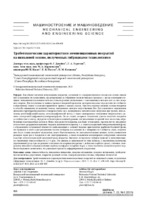| dc.contributor.author | Девойно, О. Г. | |
| dc.contributor.author | Туричин, Г. А. | |
| dc.contributor.author | Кардаполова, М. А. | |
| dc.contributor.author | Касач, Ю. И. | |
| dc.contributor.author | Погудо, Е. В. | |
| dc.contributor.author | Косякова, И. М. | |
| dc.coverage.spatial | Минск | ru |
| dc.date.accessioned | 2023-12-11T12:38:37Z | |
| dc.date.available | 2023-12-11T12:38:37Z | |
| dc.date.issued | 2023 | |
| dc.identifier.citation | Триботехнические характеристики композиционных покрытий на никелевой основе, полученных гибридными технологиями = Tribotechnical Characteristics of Nickel-Based Composite Coatings Obtained by Hybrid Technologies / О. Г. Девойно [и др.] // Наука и техника. – 2023. – № 6. – С. 450-459. | ru |
| dc.identifier.uri | https://rep.bntu.by/handle/data/138349 | |
| dc.description.abstract | Как объект изучения использованы покрытия, состоящие из самофлюсующихся сплавов на основе никеля или содержащие их композиции, сформированные в гибридном технологическом процессе с двумя основными стадиями: напылением плазменным методом и последующим оплавлением – газопламенным методом или за счет лазерного нагрева. Для полученных в данном процессе покрытий проведено экспериментальное определение их стойкости к абразивному износу в условиях граничного трения с вводом смазок. При этом изучено влияние состава покрытия и способа оплавления на величину износа, измеренного методом искусственных баз. Для оценочного определения динамики структурообразования в поверхностном слое, подвергнутом механическим нагрузкам при трении, использованы рентгенофазовый анализ, металлографический метод, а также сканирующая электронная микроскопия в режиме электронной дифракции (электронографии). После стадии лазерного оплавления удается получить покрытия со стойкостью к износу, двукратно и более превосходящей уровень для напыленных покрытий того же состава, обработанных газопламенным методом. Износ поверхности покрытия, как было установлено, происходит по механизму усталостного разрушения наименее твердого компонента покрытия, т. е. никельсодержащей интерметаллидной фазы, с образованием островковой пленки из слабосвязанных с основой твердых кристаллитов карбидно-боридной фазы, что приводит в итоге к растрескиванию частиц этой фазы и осыпанию их с поверхности. Стойкость слоев, полученных после стадии лазерного оплавления, может быть повышена, по экспериментальным данным, путем уменьшения размеров зерна фаз в покрытии и его текстурирования, а также повышения концентрации легирующих элементов в составе металлсодержащей связующей фазы покрытия. Введение легирующих добавок приводит к дополнительному увеличению износостойкости в 2–4 раза. Это связано, в зависимости от типа добавок, с увеличением количества упрочняющей фазы при сохранении пластичности матрицы (покрытия с добавками карбида хрома), степенью легирования никелевой матрицы (добавки карбида вольфрама и карбида бора), а также наличием мелкодисперсного карбидно-боридного компонента, что уменьшает процессы деформирования и царапания. | ru |
| dc.language.iso | ru | ru |
| dc.publisher | БНТУ | ru |
| dc.title | Триботехнические характеристики композиционных покрытий на никелевой основе, полученных гибридными технологиями | ru |
| dc.title.alternative | Tribotechnical Characteristics of Nickel-Based Composite Coatings Obtained by Hybrid Technologies | ru |
| dc.type | Article | ru |
| dc.identifier.doi | 10.21122/2227-1031-2023-22-6-450-459 | |
| local.description.annotation | As an object of this study, the coatings were used, which are composed of self-fluxing nickel-based alloys or compositions containing them, formed in a hybrid technological process with two main stages: spraying by the plasma method and subsequent remelting – by the gas-flame method or laser heating. An experimental measurement of their resistance to abrasive wear under conditions of boundary friction with the introduction of lubricants has been carried out for the coatings obtained in this process. At the same time, the influence of the coating composition and the remelting method on the wear value measured by the artificial base method has been investigated. To evaluate the dynamics of structure formation in the surface layer subjected to mechanical loads during the friction, X-ray diffraction analysis, metallographic method, and scanning electron microscopy in the electron diffraction mode have been used. After the laser remelting stage, it is possible to obtain coatings with wear resistance that is twice or more superior to the level for sprayed coatings of the same composition processed by the gas flame method. Wear of the coating surface has been found to occur through the mechanism of fatigue failure of the least hard component of the coating, i. e., the nickel-containing intermetallic phase, with the formation of an island-type film of hard crystallites of the carbide-boron phase weakly bound to the coating base, which ultimately leads to cracking of particles of this phase and their crumbling from the surface. The durability of layers obtained after the laser remelting stage can be increased, according to experimental data, by reducing the grain size of the phases in the coating and its texturing, as well as increasing the concentration of alloying elements in the composition of the metal-containing binder phase of the coating. The use of alloying additives leads to an additional increase in wear resistance by 2–4 times. This is due, depending on the type of additives, with an increase in the amount of the hardening phase while maintaining the plasticity of the matrix (coatings with chromium carbide additives), the degree of alloying of the nickel matrix (by the tungsten carbide and boron carbide additives), as well as the presence of a finely dispersed carbide-boride component, which reduces the processes of deformation and scratching. | ru |

